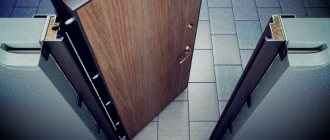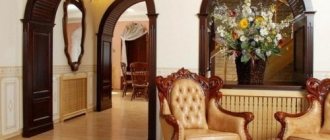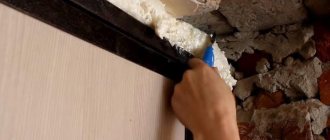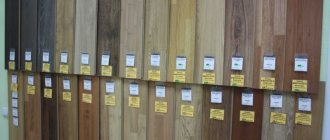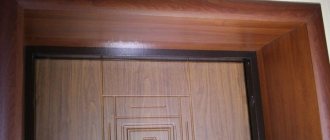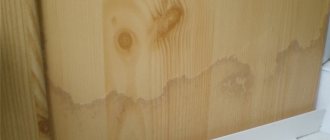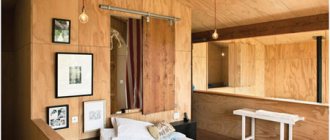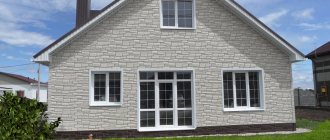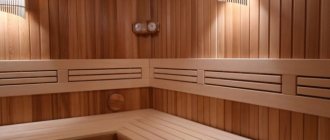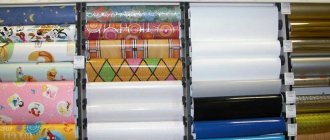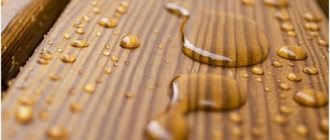Finishing metal doors yourself
New doors do not always look attractive and stylish, but this is the first thing a person sees when entering your home. Finishing a metal entrance door is done in order to diversify and decorate its appearance, as well as increase the level of sound insulation. The cladding can be done independently. You can come up with your own design and implement it on your canvases; there are several design methods for this.
Methods for decorating canvases
Cladding can be done with various materials, such as:
Before you start work, you need to select the raw materials with which you will cover the structure and prepare the necessary tools for this.
MDF cladding
Finishing metal doors using MDF is one of the most common.
This is a very economical option, but at the same time, the canvases look very stylish and neat.
The first step is to carry out the necessary preparatory work:
- Completely eliminate all gaps that are present around the doorway.
- They can be eliminated using polyurethane foam.
Installation instructions for MDF panels
Now, on the prepared opening, you can fill in special guide strips, to which you will later attach the panels:
Usually they are made no more than 30 mm in width and no more than 10 mm in length. The planks are packed around the entire perimeter. A standard size door requires about 9 meters of raw materials.
After installing the frame, the cladding is done:
- The panels can be attached with self-tapping screws.
- Corner joints are hidden using decorative corners or trims.
- The corners of the platbands should be cut exactly, at an angle of 45 degrees.
- Finishing a metal door with your own hands requires precision and accuracy; measure the corners as evenly as possible.
The gaps that appear between the slopes must be sealed with wood putty. Finishing slopes after installing metal doors, as a rule, is done immediately, so as not to remove debris several times.
MDF can be painted, laminated or veneered. Painted material is not particularly suitable for cladding, as it is not as durable. It is better to use the other two types of MDF, as they have a greater degree of strength and, at the same time, are able to withstand moisture well.
Decorating with laminate
Finishing a metal entrance door using laminate consists of the following operations:
- The first step is to prepare the surface to prevent the possibility of rust forming on the metal. The surface can be cleaned; for example, a metal brush is suitable for this. The canvas is degreased with a solvent and wiped with a rag. The resulting surface must be coated with a primer.
- Take measurements and prepare the laminate for installation.
- Remove the door leaf and place it on a flat floor. Try the part on the canvas, make sure again that everything fits in size.
- Now attach the main parts. For this you will need special glue.
Apply it to the surface, attach the part and press it with a clamp.
- Then prepare the holes intended for installing the fittings and install it.
- Reinstall the door.
Then the slopes are finished after installing the metal door. The required level of slope fastening is established. Its location point is established using a level and a rod.
Then the block is nailed to the wall, and slats are attached to it, to which the laminate will be glued.
How to decorate a metal door with your own hands using lining
This material has many positive features; it is easily accessible and widespread:
- Wood has a very high level of thermal insulation and perfectly protects against noise; the apartment will be warmer, and extraneous noise coming from the entrance will no longer distract you.
- Larch lining will be very durable and resistant to the negative effects of moisture.
How to cover a door with clapboard
Prepare the structure for sheathing. Remove the door, lay it on a flat surface, clean and disconnect handles and other protruding objects from it.
- Prepare the lining, measure and cut out the required dimensions.
- Start laying the panels from the left corner. Can be secured using clamps and self-tapping screws, which are screwed in with a screwdriver. The material can also be fastened with liquid nails.
- The following slats are inserted into each other's grooves and fastened with nails or glue.
- After completing the main work, you need to varnish the surface, dry it and install the door back.
Cladding with clapboard is very popular, since the price of this material is relatively low, and the doors are quite attractive.
Slope finishing
This work and material must be in harmony with the entire structure of the door. But sometimes it may not be possible to apply the same element. Let's figure out what can be done to finish the slopes.
Plastering and puttying of slopes
This finish is quite often used for this work. It is quite durable and can always be restored.
Moreover, it does not take much time and effort. All the work can be done with your own hands and without resorting to outside help.
So:
- To carry out the work you will need the following tools: usually a building level, a spatula, a trowel, sandpaper, beacons, mortar, masking tape.
- First, we clean the plane from the previous coating, for this we use a metal brush;
- Now the surface should be primed. This will allow the coating to have a stronger grip. It is better to give preference to deep penetration liquid. After treatment, the surface must dry;
- After complete drying, cover the box with masking tape; it is simply glued along the edge of the surface;
- Now we make a solution in a 3:1 ratio of sand and cement using M-300 cement. At the same time, we need to achieve a completely homogeneous mass. To do this, it is best to use a drill with an attachment, then the solution will be of high quality;
- After this, we take a thicker solution and install beacons. To do this, take a long rod and determine the level of application of the mixture. After this, the beacons are attached to the plane;
Attention: If after checking it turns out that you need to apply a thick layer, then you should use a construction mesh, it should be applied to the surface. It will allow a thicker layer of material to adhere well.
- First, pour the solution into places where a thick layer is required. Let the solution dry a little and then apply another layer. After this, take a rule or a wide spatula and begin to pull the solution along the beacons;
- If you have a thick layer, then this work will have to be done several times. Until the plane is completely leveled;
- After the surface has completely dried, putty should be applied. Let it dry. Cover the surface with primer. And you can paint it.
Now you know how to finish the slopes of the front door, since this type of finishing is used most often in such elements.
Making slopes from plasterboard
This finishing option is most often used if a very large layer of plaster is required:
- For this work we will need the following tools and materials: drywall, usually a level, drywall glue, square, putty;
- When everything is prepared, you can start working. First, we determine the level of the plane. To do this, we use a wooden strip with a flat plane. We set its correct placement using a level;
- After that, we need to cut the drywall to the desired width. To do this, place the sheet on a flat surface. Mark the cut line with a pencil. We shift this line from the table level by 5 mm. We apply the rail. We make an incision using a stationery knife. We move the sheet from the pillar a couple of mm. We make a break; the rail should lie pressed on the break line. We clean the edge with a plane;
- Now we simply place the cut sheet on the glue. We wait for it to dry completely and then putty the surface.
Attention: When gluing, make sure that the element is placed correctly. This should be checked using a building level.
Finishing the doorway, extensions and panel materials
Extensions and various panels can be called classics of the genre of doorway design - the first of them (extensions), due to their small width, are the best option for openings equipped with doors, and the second (all kinds of panel materials) are excellent for finishing an opening without doors, as well as for openings equipped with them. Let's take a closer look at both options.
- Finishing doorways with extensions. What are extras? In essence, this is a thin strip, which in the standard version has a width not exceeding 250mm. It can be made from any sheet materials, but in most cases it is MDF, plywood and, in rare cases, natural wood. If you have a strong desire and the presence of a certain tool, it is enough to simply make an additional strip with your own hands - saw the material and decorate it at your discretion. The installation of extensions is also quite simple - you can read about this in the article “Extensions for doors”.
- Finishing doorways with MDF and other panels. By and large, finishing doorways with panels is not much different from the previous method - the only exception is the capabilities of this material. If the additions are able to change the visual perception of the door frame only slightly, then the panels allow you to do this in the best possible way - with the help of panels, especially if we talk about material equipped with tongues, you can decorate an opening of unlimited width. In most cases, they are simply assembled from separate slats according to the principle of connecting laminate panels, which, if necessary, can also be safely used for finishing interior doorways with or without doors.
There are two technologies for installing door panels and panels in the opening - in the first case, they are secured using polyurethane foam with low polymerization pressure, and in the second situation, frame technology is used. The latter technology is more acceptable when finishing wide doorways - for example, this could be a vestibule between the entrance doors of a private house, in which the thickness of the external walls can reach 800mm.
You can learn expert advice on finishing doorways from this video.
Methods of finishing from the inside
Interior finishing of the canvas is a more complex procedure. The fact is that the decorative look here must be harmonious; it must be correctly integrated into the existing or created interior. It is important to remember about the protective function - it seems that from the inside it would be unnecessary, but it is not. The threats are not decreasing: children love to lean against the door when going outside, and pets will not mind testing the new coating for strength.
There are a number of requirements for finishing:
- The coating must have good noise absorption. That is, noise should not penetrate not only from the outside, but also from the inside: all conversations of household members should remain secret.
- Goes well with other interior items. Designers advise decorating the front door inside the apartment so that it has a connection with the interior structures. This is not a fundamental concept, the main thing is to show your taste and imagination.
The aerobatics of arranging an entrance door is considered to be its harmonious combination with the surrounding interior - The cost of materials must be affordable. The solution is considered quite strange, which will lead to the fact that the price of the fabric used for cladding will be more than a new entrance door that has an excellent decorative cladding.
So, the interior decoration of door panels can be done using the following options.
Chipboard sheets up to 6 – 8 mm thick
This is the most budget-friendly solution that helps give the surface a completely different look. It is important to consider that this product is afraid of excess moisture, so all edges are treated with sealants. Many people mistakenly believe that laminated chipboard has a small decorative range. In fact, there are many varieties, varying in color and texture, that perfectly imitate even natural wood.
Visually, laminated chipboard is not much different from MDF, but it is not advisable to install these panels outside, since their stability leaves much to be desired
MDF overlays
This is a more interesting type of panel, the use of which has one important defect - joints. The overlays are made to fit standard blades, which allows you to carry out work very quickly, even after installing the structure in the opening. This option has a wide choice, which allows you to choose the necessary solution.
On a note! Custom canvases are a great design move, but a big challenge when getting the job done. For them you will have to order MDF overlays separately.
MDF overlays have unique stability and excellent aesthetic properties, which is why this material is widely used in the luxury sector
Leather or its substitutes
Using natural materials is a serious financial investment. It is much more effective to choose artificial substitutes that have an identical appearance.
There is an erroneous stereotype that leatherette and similar materials are bad. This situation is explained by the fact that for a long time the market was dominated by products that were of low quality. Currently, the situation has changed a lot, the choice of such materials is very wide, and the quality is excellent. Of course, if you do not choose frankly cheap varieties produced by unknown manufacturers.
On a note! Even a do-it-yourself metal door frame using vinyl leather can be done by anyone. Unlike external work, internal work allows you to create the same pattern that is available for wooden structures.
“Soviet-style” dermantine is no longer used on doors, genuine leather is very expensive, the best option is eco-leather - it looks great, stretches well and lasts a long time.
In principle, to veneer the panels from the inside with your own hands, you can use any panel products. Thus, there are surfaces that were even lined with plastic parts. This option is more suitable for office premises where there is no need for excessive attractiveness.
Plastering the base of the internal door slopes
Scheme of finishing of openings.
The surface can be finished in this way both outside and inside the room.
Here it is very important not to make a mistake with its type and structure.
In the modern construction industry market there is a wide variety of materials with which you can make any surface smooth and even.
Thus, a decorative type of plaster is not afraid of temperature changes and high air humidity.
To decorate the side parts of the doorway, the following types of plasters are used:
- starting;
- finishing
- First, the base is coated with starting plaster. It is laid in several thin layers. This method will help to achieve a solid base of the plaster.
- An assessment of the general condition of the door jamb is made in advance. To eliminate visible defects, you should use starting plaster, leveling the surface to good levels. Once this job is completed, the base should dry. After this, it is cleaned with emery cloth.
- Then a finishing coating is applied to the finished surface, which completes the work begun by the previous material. It masks the remaining potholes and chips as much as possible. As soon as the surface dries, it is sanded.
- As soon as the above work is completed, painting of the finished base or wallpapering it begins. In this case, you should choose a material that suits the appearance of the room.
How to beat a wooden door
It is more convenient to work on a removed door, but if this is a problem, you can beat it right on the spot. First you need to remove all the fittings from the door leaf - locks, latches, door peephole. If there is old upholstery, it is carefully removed. If part of the door requires repair, the damaged fragments are removed and replaced with wooden ones cut to size. The cracks can be covered with putty or foamed with polyurethane foam with a low expansion coefficient.
Options
If there was a pattern on the upholstery, and you are generally satisfied with it, we drive regular nails into the places where the nails forming the pattern were driven. We do not hammer them in completely, the caps should stick out by 1-1.5 cm. With their help, we will then break through the foam rubber and upholstery in the right places (just press with your fingers, all layers will be pressed through). We will take out ordinary nails, install decorative ones in their place, and use tape to form a pattern. The procedure is simple.
With roller
To make the end of the door look no worse than the rest of the plane, we start with it. If you are not going to finish one of the sides, skip this step, just paint the end with paint to match the finish on one side or the other. If we are going to upholster the doors on both sides, we cut out a strip of material about 10 cm wide. Look at your door more precisely, since the thickness of the sheet varies. The strip should cover the end and extend on one and the other side by 3-4 cm. Lay the strip, fasten it along the edge with staples (faster and easier) or nails with a large flat head.
We attach the strip to the end
To form a roller, you also need a strip of material. Width - 10-15 cm depending on how wide you want the roller. Then there are two options:
- Immediately form a roller. To do this, a rope of foam rubber or batting is placed in the middle of the strip and crimped in the middle. In this form it is fixed around the perimeter of the door. Afterwards, foam rubber and material are laid on top. To form a neat edge, the material is folded inward.
The roller is formed immediately and is attached ready-made around the perimeter of the canvas. - The roller is formed later, after the vinyl is laid on the canvas. Here the technology is different - the strip is attached around the perimeter, face down. Then the foam rubber and upholstery material are attached. The edges are not rolled up, just cut to size. After finishing, the strip is folded onto the front side (a strip of foam rubber can be placed in it), folded and secured with wallpaper nails.
The strip for the roller is fixed in advance; the roller itself is formed after the upholstery material is fixed
The difference between these two methods is only in appearance: in the first case, the nails are nailed along the edge of the upholstery (pictured on the right), in the second - along the edge of the bolster (pictured on the left). They choose who they like best. For example, it seems to me that the first option (on the right) looks better - more neat. But this is just a personal opinion.
Two options for forming a roller
What is this roller for? In order to cover possible gaps between the canvas and the jamb. This way we avoid drafts and reduce heat loss. But you can make a roller only if the doors are upholstered on the opening side (the doors open into the apartment, so we upholster them from the inside). If, on the other hand, this trick doesn’t work, it won’t close. Then you have to do without a roller.
Without roller
In this case, everything is simple: the canvas is folded evenly, fixed with nails or staples - whichever suits you best.
Without roller
A few words about the box and slopes
The jamb is an element of the door frame. That is, the U-shaped frame has one top jamb and two side jambs. The rectangular frame, in addition to the top and sides, also has a threshold jamb. Repair of this element of the entrance structure, as a rule, consists of painting or varnishing it.
If the structure is metal, you can optionally stick a laminating film on the jamb. But upholstering the box with dermantin or plywood will not work, because in this case the door simply will not close.
After the upholstery material has been replaced, the slopes can also be updated. Laminate, MDF, artificial stone, balsa wood, mirror panels, etc. can be used for this.
Thus, upholstering the front door is not so difficult. And if you give free rein to your imagination, you will get a real masterpiece.
Sheathing methods inside and outside
Decorative cladding is most relevant for metal doors, which are often installed at the entrance to an apartment or house. Such fabrics are superior to their analogues: their protection indicators and service life are higher. However, cold metal does not always harmonize with the warm colors of the hallway. To make the door look organically in the setting, it is sheathed on the inside. Old wooden, fiberboard and chipboard canvases can also be decorated.
To improve aesthetics, doors are painted, covered with decorative films or covered with leather. The most economical and energy-consuming method seems to be cladding with linings made of plastic, wood, MDF and chipboard. The panels are easy to install, low maintenance, and durable. Many increase the protection and thermal conductivity of the door.
Finishing materials for door slopes
When installing a door, its slopes also need additional finishing, especially if the door was not installed in the old frame, but was completely replaced. Finishing door slopes is not always among the responsibilities of installers installing doors. Often you need to order it separately or do it yourself. The following materials are used for finishing slopes:
- Special additions that can be matched to the doors or made in contrast with them. The most convenient for installation are telescopic extensions with a special groove for installing an L-shaped casing.
- MDF panels, laminate or plasterboard, for which the construction of a frame is required when installing slopes. There are certain difficulties when masking cut ends and fitting parts to each other. Decorative corners of various types are used for these purposes.
- Plastering and painting. The slopes are leveled using cement mortar, puttied and painted to match the walls.
- Tiles, decorative stone and mosaic for finishing are used to increase the strength of the slopes, while it is desirable that the material is also combined with the interior in the hallway.
How is the trim attached to the door?
It is unlikely that difficulties will arise when attaching the finishing material - if you act in accordance with the instructions
To answer the question of how best to attach one or another section to a metal door, you should pay attention to the condition of the structure. Also, a lot depends on what exactly you decide to cover your front doors with.
If you decide to use laminate or MDF, the panels are simply glued to the surface - this is quite normal.
Here are some recommendations to consider:
- In order for adhesion (adhesion of materials to each other) to be optimal, the surface of the door is usually primed. This measure is necessary - otherwise there is no hope for strength;
- To attach trim pieces, you can always use an adhesive called liquid nails. And additional fixation of the decorative layer is metal corners, these are also often used;
- This method is even suitable for fixing lining. But everything is different in the situation when you use a board made of natural wood. It’s just that the weight of such wood is heavier than MDF panels – many times more so. So in this situation it’s easier to use nails - it will be an order of magnitude more reliable.
Watch the video: finishing metal doors, this material will probably be useful. Especially for beginners.
In all other cases, professionals recommend using gluing - nails significantly damage the front side of the panels.
Specifics of finishing
The specific operating technology is determined by several factors:
- a wooden or steel door is made;
- features of the material chosen for cladding;
- the need for additional insulation of the sash.
But basically all the methods are similar and are performed according to a single algorithm.
- Dismantling the old cladding (if any).
- Visual inspection, identification of defects and their elimination. For example, it is better to replace the insert in a paneled door with a cheap sample made of thin plywood than to leave a damaged one in place, hoping that it will be hidden by the cladding. It won’t be visible, but what about heat loss through such an opening?
- Before covering a wooden door, it is treated with special preparations (fire retardants, antiseptics). To increase durability, depending on local conditions, the canvas may need to be treated with primer, or even applied with cheap water-repellent paint.
- Determining the layout of the facing material (slabs, sheets) and measuring the linear parameters of the sash. Based on these data, samples are cut into separate fragments. The same applies to insulation (isolon, foam rubber, thin polystyrene foam, etc.).
- Attaching the thermal insulation layer. When applied to a wooden door, one of the practiced schemes involves arranging rollers around the perimeter of the door leaf. How expedient this is is up to the master to decide, since there are other methods for leveling the gaps between the sash and the frame. For example, gluing fiberboard strips to the end of the canvas, reinstalling hinges, installing decorative corners, and so on. Given the variety of choice of cladding materials, the option with rollers is outdated. In addition, it is in these areas of the door that the wear of the trim is most intense.
- Fastening of facing material. Regardless of whether this is done with glue or staples, nails, the work begins with the top part. After fixing the leaf along the width of the door, its orientation is checked, the absence of displacements and distortions along the entire length of the leaf. Next is stretching it and securing it on the sides. The bottom comes last.
What to consider:
- For a metal entrance door, you should choose trim that is fixed by gluing. It is not advisable to drill steel, since in the future the idea may come to change the external design of the canvas. And empty holes in it are ways for cold to penetrate.
- Do not forget about the maintainability of the cladding. This applies not only to its material, but also to its insulation. For example, if it is mineral wool, then it will need to be replaced regularly. The reason is that this insulator accumulates moisture. In addition, it gradually sags, which is reflected in the level of heat loss.
It turns out that door trim is one of the best options for its reconstruction, which can be combined with insulation of the opening. In addition, any of the practiced techniques is completely doable independently, without outside help. And if the canvas has become dilapidated, do not rush to buy a new one - putting it in order, giving it a different look is not at all difficult, and it will cost much less.
Door upholstery with dermantine
The most popular way to cover a door is with artificial leather. This section allows, at the same time as improving the appearance, to increase the thermal and sound insulation performance. But this type of door trim also has its disadvantages - this is the most complex technological process, requiring at least a general understanding of the procedure.
Upholstery methods
We will talk about the technology of door upholstery with dermantine. You can attach it in two ways: with a roller around the perimeter of the door leaf and without it. Depending on this, the order of actions changes (more on this later).
Door upholstery with dermantine - with and without a roller
Next, a geometric pattern can be formed on the surface of the upholstery using nails and constrictions. Several options in the photo below.
Examples of patterns for door upholstery with dermantine
For banners, you can use the same material that was used to trim the doors. It is cut into strips 2.5-3 cm wide, attached to the top nails, and then pulled and fixed by the next nails to form a pattern. To secure the strip, you can wrap it around a nail that is not completely driven in, which is then driven in. But this option is suitable if decorative nails have large heads. If the caps are small, the strips are nailed.
The pattern can also be formed using a thin metal flexible cable, but it is more difficult to attach - it bends less easily.
How and with what to attach leatherette to the door leaf
If you need upholstery on a wooden door, there are usually no questions asked - they are fastened with staples and then nailed along the contour with decorative nails. Only here there are nuances: the staples must have a wide back (at least 1 mm), and the nails must be wallpaper nails with a wide head. The fastener installation step is from 2.5 to 7 cm, as desired.
The most commonly used wallpaper nails
More questions arise when it is necessary to cover an iron door with dermantine. There is only one way out - to plant it on glue. “Moment” glue is usually used, but you can use any other universal glue that can be used to glue both metal and leatherette. It is used to lubricate the strip from the inside (the strip that runs along the perimeter of the door and covers the junction of the leaf with the door frame). When attaching vinyl artificial leather, it is cut out with a margin of 15 cm, just for the hem on both sides to the wrong side.
Materials for heat and noise insulation
Foam rubber is most often used to insulate doors. It is inexpensive and, if desired, allows you to create a voluminous convex pattern. The most common case is two layers of foam rubber, 1 cm each. This option is not the best - foam rubber has almost no effect on the soundproofing properties of the door, and this is what is sometimes very important. In addition, after 3-4 years it loses its elasticity, begins to stick together, and you have to reupholster the door, although the appearance of the leatherette is still quite decent.
All this is true, but there are no worthy competitors for foam rubber yet. There are materials with certain properties that can be laid instead of one of the layers, and the second will still be foam rubber. For example, to improve sound insulation properties, you can use Isoton. It is used for heat, sound and insulation of cars. Sold in small sheets, an adhesive composition is applied to the back side, protected by plastic film. So there will be no problems with installation. The disadvantages are the price and the rather large weight of the material. To avoid problems, it is worth replacing the hinges with more powerful ones.
Materials for noise, heat and door insulation
There are two other materials used in the automotive industry with similar properties. These are “Splen” and “Vibrofilter”. All of them are made on an adhesive base and can be used to improve the characteristics of the door.
Finish options
Before you start work, you should figure out how to cover the front door. There are quite a lot of methods, but when choosing the optimal one, you need to take into account local specifics.
- What opening does the door close - at the entrance to a private house or apartment in a multi-storey building?
- The base material to be decorated.
- Own capabilities, including the availability of one or another tool.
- How difficult is it (possible on your own) to replace the door trim as it wears out?
Lining
Plastic panels are not suitable as a material for lining entrance doors, although they are sometimes used. Their main disadvantage is their rapid “burnout” under the influence of ultraviolet radiation. Therefore, only slats made of MDF or solid wood. If the samples are properly treated with special preparations, primarily antiseptics, then there will be no problems with the sash for a long time.
But here we cannot ignore the characteristics of different types of wood. To cover entrance doors made of metal or wood, if they are installed in a private house, you should focus on larch. It is maximally resistant to dampness, and when wet it only gains strength. But for finishing the panels covering the openings leading to the apartments, cheaper spruce or pine are also quite suitable.
Laminate
An equally popular material that attracts buyers with a variety of shades. After such finishing, no additional surface decoration will be required. Covering doors with these panels is done quickly by gluing them. But given the disadvantage of laminate - hygroscopicity - it is advisable to use it only at the entrance to the apartment.
Plywood
Naturally, we are talking only about multilayer sheet material. When choosing, you should take into account its variety; Among the budget options, FC and FSF products are suitable. The first does not like excess moisture, but does not contain phenol in the glue that holds the veneer together. Therefore, it should only be used for upholstering the entrance metal (wooden) door from the wrong side of the door. FSF sheets are recommended for installation outdoors, since the adhesive composition contains toxic components. But it is inert to moisture, therefore, in all respects it is suitable for the outer cladding of the sash.
The best option is shiplap plywood. But it is not widely used in everyday life due to its high cost.
MDF panels
One of the cheapest materials that can be used to quickly cover the front door. Further decoration of the canvas depends only on the imagination of the master - with film, painting, varnish (with or without tinting) and so on. But there is a significant disadvantage - a large specific gravity. Therefore, it is necessary to take into account the reliability of the loops. Moreover, if at the same time it is decided to insulate the sash.
Most likely, the awnings will have to be replaced. It is unlikely that this cladding option is suitable for a metal door with hidden hinges, especially if everything is done independently.
Fiberboard sheets
Another budget-friendly way to reconstruct paintings. But it is advisable to use only for apartment doors. Low mechanical strength and hygroscopicity make fiberboard unsuitable for cladding doors at the entrances to private buildings.
Viniplast
Sheet material is also quite cheap and easy to install. It is advisable to use it for cladding steel sheets, since at the same time it is an excellent insulation material. In order not to deal with the decoration of the metal entrance door in the future, you should focus on the modification of VD (decorative vinyl plastic).
Leather vinyl
There are many advantages - low cost, variety of textures and shades, inert to dampness, easy to clean. You can sheathe any fabric, and according to different patterns. Using nails with decorative caps, cords, ribbons, etc., the door is given a different texture; it is divided into rhombic, rectangular and other sectors depending on your own imagination.
But there are also disadvantages of covering the valves in this way - the low mechanical strength of the material and instability in the face of aggressive “chemistry”.
Leatherette
The traditional method of reconstructing paintings is one of the simplest and cheapest. However, this finish is short-lived due to brittleness at low temperatures and insufficient strength. As an option - for decorating paintings from the inside or at the entrance to the apartment.
PVC film
When deciding how to sheathe a door, it is worth considering this option. It has disadvantages - the fragility of the layer, weak mechanical strength and elasticity. The last factor will not make it possible to mask defects in the canvas in the form of depressions. But all this is fully compensated by the high speed of restoration, ease of surface care and low price of the film.
Preparatory work
The process of preparing the door leaf is the same for all materials. Consumables are purchased with a small reserve.
Before sheathing a metal door, you need to:
- remove it from its hinges, you can put it on stools to make it convenient to work;
- dismantle fittings (handles, peepholes, locks);
- clean the canvas from dirt.
https://youtu.be/0ukuhbxYSZ0
If necessary, the structure can be washed; detergents are selected depending on the material. Detected defects are eliminated: fungus, mold, rust stains. A moisture-proof, antiseptic or other coating is applied to the canvas.
The sheathing material must be unrolled 1-2 days before the start of work so that the folds on it straighten out.
To sheathe the front door with your own hands, you will need gloves and a set of tools.
Tools
They are selected depending on the specifics of the work, the material of the door leaf and the material with which the door is finished.
Standard set of tools:
- measuring instruments - tape measure, square;
- cutting - scissors, hacksaw;
- fasteners - simple and decorative nails, self-tapping screws, epoxy glue or liquid nails;
- hammer - if the upholstery is fastened with nails;
- brush, roller - if the canvas is covered with paint and varnish.
To dismantle the fittings, you will need a set of screwdrivers and pliers; for accurate upholstery work, you will need a marker and a construction pencil.
Using a professional tool, such as a furniture stapler, will help speed up the process. The screwdriver can be replaced with a drill with a special attachment,
Decoration Materials
Nowadays, the range of entrance doors to apartments is impressive.
Nowadays, many people choose metal doors for their homes. There is nothing surprising in such a choice, because such a design can be called comfortable and durable. There are also many design options here, and the color can be any. Some people make doors to order, while others do this work themselves.
Now let's look at the situation in more detail:
In general, how to decorate a metal door is not such a difficult question. On the market today you will find plenty of materials for such work. In addition, nowadays there are enough specialists who are ready to offer help and their services - due to this, the work can be significantly simplified.
Apartment decoration: doors should be beautiful - there’s no way around it
- A simple example: an iron door can have a wood finish, and wooden structures are often decorated with marble. That is, you will not only make the door in the apartment more beautiful - you will also be able to mislead your neighbors about the original building materials;
- Also, this feature allows you to translate into reality the most unusual ideas related to arranging the interior of your home;
- Do not forget that the finishing material for doors should not only have an attractive appearance, strength, frost resistance, moisture resistance and other important parameters are also important here. You want your new door to remain in its original form for as long as possible?
What to choose for interior decoration?
The interior decoration of doors is important in the interior of the hallway
Apartment decoration - doors: this is exactly what we are talking about in the article. Let's figure out what material you should choose for lining your door from the inside.
It is important to approach the selection carefully - the material should not only be bright and beautiful, but also of high quality. It should also fit the overall design of the hallway
Try to consider the following:
- When your hallway has doors leading from other rooms, it is best to make the entrance doors in the same color as theirs. This is a very aesthetic technique - the entrance door will definitely not stand out against the background of other doors;
- In the case where the area of the hallway of the room is small, the inner surface of the entrance doors can be made mirrored. This is ideal for situations where there are no small children living in the house. Otherwise, there is a high risk of injury;
- If you are planning to insulate your doors, the sheathing should be done from the inside. It is unlikely that it will last long outside, especially if the door has access to the landing.
What can you choose? There are many options:
- Many people choose wood;
- A leather substitute is often used for door trim;
- The use of plastic panels cannot be ruled out;
- Self-adhesive film is popular;
- Remember also about paint and other options.
What to choose for exterior door decoration?
The importance of exterior cladding cannot be underestimated
When finishing the inside of the doors, you can be guided by how the interior doors are decorated. What can we say about the outside? She will definitely experience serious stress. It is the external side that is inextricably linked with temperature changes, fluctuations in humidity levels, and the hooligan actions of various intruders.
That is, you must take into account all these features when finishing apartments, namely, covering the doors. The outside of the front door needs to be finished correctly.
Self-cladding is often performed using the following materials:
- MDF panels are often used;
- A popular material is PVC film;
- Lining is used actively, like veneer;
- Many people choose laminate flooring.
You can easily find similar materials at your nearest hardware store; working with them is not at all difficult. In general, almost all of them are reliable and durable.
Your front door might look like this
Vinyl leather is a material that is very common today and is used for lining entrance doors. It's not that expensive; To improve the level of sound insulation, it is also customary to place a layer of foam rubber between the leatherette and the metal door - this also provides additional insulation; MDF panels also have excellent characteristics. They imitate natural wood well, contribute to sound insulation and thermal insulation of your entrance doors; If we consider prices, then a lot depends on the specific manufacturer. Don’t forget about the quality of the material - this is a very important factor.
Cost may vary; It is very important that you choose the right material that is best suited for your doors.
Laminate
This material is more associated with floor finishing, but in fact, it can be successfully used for cladding an iron door. The thickness of the planks is 8 mm, and includes four layers. The bottom one is made of waterproof paper, which is impregnated with resins and paraffin. The next layer is wood fiber material. The top ball is also paper, it is painted and a design is applied to it. The final fourth layer is a polymer film; it performs protective and antistatic functions.
Laminate, as a material for finishing iron entrance doors, has many advantages:
- low cost: although there are more expensive varieties of this material, laminate is still cheaper than natural wood, although it is not inferior to it in terms of decorative properties and other indicators;
- a wide range of colors and patterns, most often such products are made as imitation of natural wood of various species;
- UV resistance: laminate does not fade;
- good insulating properties (from noise and to retain heat).
- mechanical strength, resistance to scratches and damage.
In addition, the laminated coating is easy to care for; it can be wiped with mild detergents. The only drawback of this practical material is the inability to decorate external doors that go directly to the street. Severe frosts and especially high air humidity are contraindicated for laminate. Therefore, the material is best used for cladding steel doors in apartments of a multi-story building.
The laminate sheathing installation diagram looks like this:
- First, a frame is made from wooden slats; they must match the color of the laminate used. It is fixed to the door leaf using liquid nails.
- A sheet of the required size is formed from the laminate panels, cutting it with a jigsaw.
- Glue is spread over the canvas, after which the laminate shield is pressed against the door.
- In order for the materials to “grab” better, the laminate finish is pressed against the canvas with some kind of weight, and left until completely dry.
- The last stage of lining an iron door from the inside is the installation of fittings.
Internal upholstery
A type of finishing work that was popular in the past and is experiencing a rebirth. A door upholstered with natural or artificial materials has an attractive appearance, helps create warmth and comfort in the apartment, can be combined with almost any design solution for decorating an apartment, retains heat well, and provides decent sound insulation.
When you decide to frame your front door, you get the following benefits:
- Durability (the door will last from 10 years);
- Affordable rates for finishing;
- Easy to care for: easy to clean, withstands dry cleaning;
- Moisture and frost resistance;
- Immunity to UV rays;
- Large selection of textures and colors.
The main disadvantage of upholstery is the flammability of the materials. The coating can easily be damaged by a sharp object, after which it will have to be replaced completely, since the damaged fragment cannot be restored.
Upholstery materials
The door is upholstered with soft materials - substitutes for natural leather based on vinyl and its derivatives. This choice is explained by the performance qualities of the coating:
- Resistance to rotting;
- Attractive price;
- Abrasion resistance;
- Easy to care for;
- Variety of textures and colors;
- Durability.
Types of coatings
Painting is carried out using various types of coloring compounds. The most common types of paints are:
- Nitroenamel.
Reliably protects an iron door from corrosion, has an attractive price, dries quickly, and is equally effective when applied either with a brush or with a spray gun. The disadvantages include a short service life - the composition quickly darkens. - Oil paint.
Apply in an even layer to any surface, suitable for both steel and wooden doors. The material is durable, gives the surface an aesthetic appearance that is preserved for a long time, does not fade in the sun or get wet, and withstands mechanical loads. Among the disadvantages of oil compositions are the drying time, low coverage rate, and rapid wear. - Acrylic enamel.
It has a high drying rate, the ability to be applied to any surface, long service life, and no combustion. Not suitable for exterior painting. - Alkyd enamel.
It is resistant to thermal changes and UV rays, dries quickly, maintaining a glossy shine for a long time. Due to these characteristics, the material is often used for exterior door decoration.
The type of coloring composition is selected according to the personal preferences of the home owner, as well as the general environment.
- Door laminated on both sides + sound insulation mineral wool VLD 006
- Inexpensive powder-coated apartment door VVD 005
- Iron door with MDF wenge finish with sound insulation VFD 001
- Metal door with MDF finishing with good noise insulation VFD 026
- Brown door with MDF panels for a private house VFD 031
- Metal door with powder coating and sound insulation PNM-8
Finishing with marine plywood
A special feature of marine plywood is its high strength, resistance to moisture and the ability to withstand significant temperature fluctuations without consequences. The material acquires similar properties due to its treatment with stain and coating with a protective, frost-resistant varnish.
From the outside, plywood looks like solid noble wood and looks very attractive. However, the high cost of this material does not allow everyone to use it for finishing doors.
Laminate finishing
Laminated panels , in fact, also refer to a type of glued-pressed boards consisting of wood fibers. A special film is applied to the surface of such slabs at high temperatures, which is highly durable, antistatic and has the ability to repel water. Thanks to this film, the panels, even with a small thickness (about 7-8 mm), can withstand mechanical loads and temperature changes well.
Features of the choice of materials
Correctly sheathing the sash is not enough to achieve the desired effect. You also need to understand what exactly it is. Dermantin is commonly called differently: leatherette, granitol, eco-, amidis- or vinyl artificial leather. The latest technologies make it possible to supply the market with material in various modifications, differing in texture, shades and a number of properties. Therefore, dermantin gradually became a generalized term. But door upholstery with leather (natural or its synthetic analogues) is produced using the same technology, with only slight variations, depending on what goals the master is pursuing (just decoration or also insulation), and what the canvas is made of (metal, wood) .
